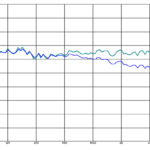How to set up the high frequency decay of the Nearfield, Middlefield and Farfield spkeaers for Home use? (4 replies)
Hi Vinssen,
I am interpreting your question to be understanding the sloping of the high frequency (HF) response at various distances from the speaker. The near field is usually defined as within 1 meter of the speaker; here we will see no sloping of the HF response. A measurement at this distance is often considered similar to the anechoic (no acoustical distortion) response. This distance is most often used in recording studios and some would argue many audiophile systems are close enough to be mainly a near field signal. It's important to understand that this non-sloped or flat response is considered to have too much HF and thus is not the best. Speakers placed this close to the listener should be equalized (EQ) to have a sloped response to sound correct. This is usually already accomplished in the cross-over of near field studio monitors, but it can be adjusted by a slight adjustment of a treble tone control for other speakers.
In small room acoustics, we rarely discuss the middle field. The reason is that the defining distance for the far field, the critical distance, is usually in front of any listeners in a proper listening room. The key to understanding the best sloping is matching the frequency response of your system to the frequency response of the recording or mastering studio where the recording was mixed. For most high quality movie studios, the dubbing stage has a strongly sloped HF response. For most music studios, there is a much lesser but still sloped response. The difference is due to the size of the mastering room; large rooms are calibrated to have strong sloping and small rooms use much less sloping. In our home theater or listening room we generally desire a less sloped HF response but certainly not a flat response. It is the calibrator who can determine this but, again, a consumer can simply adjust the treble control to their preferred sound. I have attached a picture of a "flat" near field measurement versus a preferred "sloped" listening position measurement to help clarify my comments.
I should add that movie sound tracks are often not re-mastered for home theater use although more and more are. An untouched movie sound track is usually considered too bright (not enough HF sloping) because it was designed to sound good in a large theater with a much more sloped HF response. Most home AVRs offer a compensation control designed for such sound tracks but it must be manually turned on. An acceptable alternative is to again use the treble control to adjust the sound to the users preference.
This is a complex subject. I invite any questions.
Hi Gerry
Frankie wants to know if the HF response sloping has any relationship with the listening distance. How to estimate them?
Hi Frankie,
Yes, the sloping is a function of speaker to listener distance. Nearer to the speaker you see less sloping because the direct sound (which is flat) is dominant. As you move farther away, more of the sloped off axis sound of the speaker is combined with the direct sound creating a more sloped response.
Besides distance, other factors can affect the sloping. For example, a room which is over damped (too much absorption) can have less sloping because the sloped off-axis sound from the speaker is being absorbed. Also, some speakers have better off-axis response which reduces the sloping. In either case, the correct sound is obtained by matching the sloping of your speakers response to match the required sloping of the recording. This done through calibration or the use of the treble control.


How to set up the high frequency decay of the Nearfield, Middlefield and Farfield spkeaers for Home use?